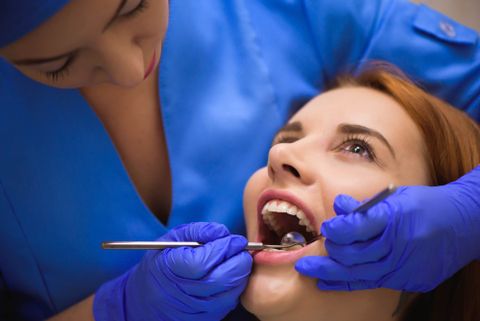Cosmetic Dentistry
Cosmetic Dentistry
Cosmetic Dentistry Procedures
A successful smile makeover is a team effort between you and the dentist who treat you. Depending on which procedures you choose, other highly skilled professionals may also play a crucial role. The first step in any smile makeover is a thorough dental examination to make sure that your cosmetic problems really are just that, and not a sign of underlying dental disease. The most common cosmetic dentistry procedures include:
Cosmetic Bonding
Often, bonding is used to improve the appearance of your teeth and enhance your smile. Composite material, either a plastic or resin, is bonded to an existing tooth, and comes in a variety of colors to match the natural look of your teeth. Unlike veneers or crowns, bonding removes little, if any, of the original tooth. Bonding is a common solution for:
- Fixing or repairing chipped or cracked teeth
- Reducing unsightly gaps or spaces between teeth
- Hiding discoloration or faded areas on a tooth's surface
Aesthetic contouring refers to a procedure in which our dentists can reshape your teeth by sculpting the sides of the teeth. This can correct cracked, chipped, crooked, or misaligned teeth. Instead of braces, crowns, or veneers, you can choose to have aesthetic contouring to change the shape and look of your teeth to enhance your smile!
Crowns & Bridges
A dental bridge is a device that fills a space another tooth previously occupied. A bridge may be necessary to prevent shifting of surrounding teeth. Shifting teeth can lead to bite problems (occlusion) and/or jaw problems. Bridges safeguard the integrity of existing teeth and help maintain a healthy, vibrant smile. There are three main types of bridges:
- A fixed bridge is the most popular and consists of a filler tooth that is attached to two crowns, which fit over the existing teeth and hold the bridge in place.
- The Maryland bridge is commonly used to replace missing front teeth and consists of a filler that is attached to metal bands that are bonded to the abutment teeth. The metal bands consist of a white-colored composite resin that matches existing tooth color.
- The cantilever bridge is often used when there are teeth on only one side. A typical three-unit cantilever bridge consists of two crowned teeth positioned next to each other on the same side of the missing tooth space. The filler tooth is then connected to the two crowned teeth, which extend into the missing tooth space.
A crown is a custom-made cover that fits over an original tooth that is either decayed, damaged, or cracked. Crowns are made of a variety of different materials such as porcelain, gold, acrylic resin, or a mix of these materials. Porcelain generally has the most natural appearance, although it is often less durable. The treatment plan for a patient receiving a
crown
involves:
- Numbing the tooth to remove the decay
- Sculpturing the tooth to provide an ideal fit for the crown
- Making an impression of your teeth in order to create a custom-made crown (usually takes 1-2 weeks)
- Making a temporary crown out of acrylic resin and fitting it onto the tooth
- Applying the custom-made crown by removing the temporary crown
- After ensuring the crown has the proper look and fit, the dentist cements it into place
This process generally consists of 2-3 visits over a 3-4 week period. Once the procedure is completed, proper dental hygiene, including daily brushing and flossing, is required to maintain healthy, bacteria-free teeth, gums, and crowns. This helps in the prevention of gum disease. Given proper care, your crowns can last a lifetime.
Dental Implants
Dental implants are designed to look, feel, and function like your natural teeth. They are used to replace missing teeth and provide a foundation for crowns, bridges, or dentures. Implants also help preserve tooth-supporting bone that naturally deteriorates when a tooth is lost. Bone loss is one of the major consequences of losing teeth.
A dental implant most often takes the form of a small, screw-shaped titanium post that replaces the root-part of a missing tooth. The surgical procedure used to place an implant is quite minor and routine, requiring only local anesthesia in most cases. After a healing period, the implant is topped with a lifelike crown, custom-made to match your existing natural teeth. Implants have a documented success rate of over 95%, which is significantly higher than any other tooth replacement option.
When you have more than one tooth missing, implants provide an ideal replacement mechanism. You don't need one implant for every missing tooth. Instead, implant teeth can act as supports for fixed dental bridges. Implants can also support an entire arch of upper or lower replacement teeth that are fixed into the mouth and are never removed. Sometimes the new teeth can be supported by as few as 4 implants. In cases where jawbone density, and volume, have deteriorated, 5-6 implants might be needed to support a row of 10-12 teeth. Implants can even make removable dentures more comfortable, effective, and healthier to wear. Traditional dentures rest on the gums and put pressure on the underlying bone which can promote bone loss. Today, dentists can attach a removable denture onto implants, transferring that pressure into the bone structure rather than the bone surface. This prevents the dentures from slipping while you eat and speak, and preserves the bone directly beneath them.
Porcelain Veneers
Veneers are thin, semi-translucent shells, typically attached to your front teeth. Veneers are customized from porcelain material that is bonded to your teeth. Veneers are a great aesthetic solution to your smile that may even help you avoid orthodontic treatment. Subtle changes to your smile can be achieved with veneers, and in most cases, veneer application is completed in only two office visits. Common problems that veneers are used for:
- Spaces between the teeth
- Broken or chipped teeth
- Stained or discolored teeth
- Crooked or misshapen teeth
Teeth Whitening
Your teeth will darken over time. Changes in the color of your teeth can be caused by food and beverages like coffee, tea, and soda. Other known factors for discoloration include tobacco use or improper oral hygiene.
Teeth whitening services are growing in popularity, and it's one of the most requested services offered by our practice. There are three methods available for bleaching your teeth: in-office, overnight, or daily. One of the methods used by our practice is a gentle hydrogen-peroxide gel-activated solution. Our process will whiten your entire smile in one visit. The in-office bleaching generally lasts one and a half to two hours, and you can read or relax during the treatment. For overnight bleaching, we make an impression of your teeth and create a mouthguard that fits your bite. Each day you fill the mouthguard with a small amount of bleaching gel and wear it overnight or for a few hours during the day. The overnight bleaching process takes approximately two weeks.
Microabrasion is a simple procedure used to remove stains and discoloration from teeth. Stains and spots on teeth can be caused by several factors, including: braces, medications, trauma, development abnormalities, and smoking. Many times, whitening does not work because the stains are deep and can be difficult to remove. Microabrasion is effective because it can reach the deeper areas of enamel. Using hydrochloric acid and pumice, microabrasion gently removes very thin layers of enamel, thus removing stubborn stains and discoloration. Microabrasion is safe and painless – and does not damage your teeth.
Nothing improves your appearance more than a bright, white smile!
Your Smile Makeover
The most important job you have is to communicate exactly what you don't like about your smile and how you would like it to be different. Before your first consultation, give some thought to the following questions:
- What do you like or dislike about the color, size, shape, and spacing of your teeth?
- Are you pleased with how much of your teeth & gums show, both when you smile and when your lips are relaxed?
- Do you want teeth that are perfectly aligned and white, or would you prefer a more natural look?
It is extremely helpful for you to bring in pictures that show the results you are aiming for. It is impossible to overstate the emotional, social, and even professional benefits that smiling with confidence can give you. If you find that you cover your mouth when you smile, or even hold back your smile because you don't want to show your teeth, you should consider what cosmetic dentistry — the art of smile enhancement — can do for you.







